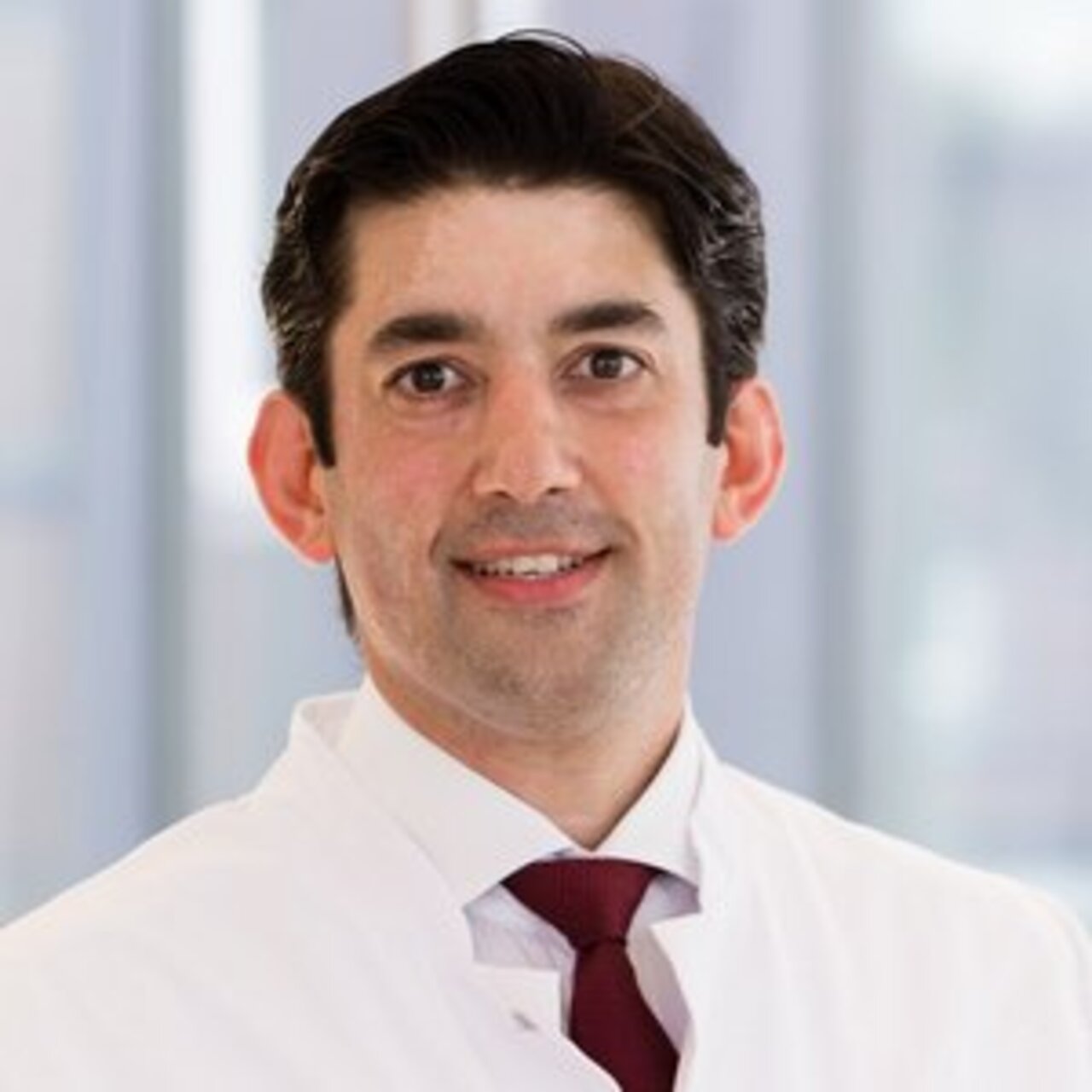Specialists in Aortic Stenosis
7 Specialists found
Dr Brunilda Alushi, PhD, FEACVI
Internal Medicine and Cardiology, Prevention and Imaging Diagnostics
Munich
Information About the Field of Aortic Stenosis
What is aortic stenosis?
Located between left ventricle and aorta, the aortic valve is a ring-shaped connective tissue. The aortic valve opens during the so called systole, enabling blood to enter the aorta, and shuts during diastole, preventing blood from flowing back into the left ventricle from the aorta.
Aortic valve stenosis ( frequently referred to colloquially as aortic stenosis) refers to an abnormal narrowing of the passage through the aortic valve, which may lead to numerous health problems.
What is the result of aortic valve stenosis?
On account of the stenotic aortic valve ("clogged valve"), the left ventricle must work harder to meet the increased workload. Consequently, structural changes occur in the cardiac muscle of the left ventricle in an attempt to adapt to the increased workload by hypertrophy (muscle growth). Early on, there is concentric thickening of the left ventricle, resulting in a stronger pumping capacity of the heart and thus cardiac output can be kept at a constant level.
Eventually, the increased pressure on the left ventricle causes dilation (expansion) of the heart wall, which may result in significant drops in cardiac output. Ultimately, the diminished performance of the heart can lead to left-sided heart failure, that is a condition in which the heart is incapable of adequately supplying the body with blood.
Causes and symptoms
Among the most common causes of aortic valve stenosis is age-related calcification of the valve. Far less common, although particularly encountered in younger patients and especially in children may be congenital defects of the valve.
Mild and moderate stenosis of the aortic valve may often remain asymptomatic over a long period of time, and the associated risk may not be recognized early enough. The reason for this is that the muscle hypertrophy of the left ventricle can compensate up to a certain point for the narrowed passage through increased force. During these stages, however, symptoms may be most evident particularly during physical activity. Such symptoms include dizziness or even blackouts, attributable to reduced blood flow to the brain. This is followed later by continued left-sided muscle gain, which results in compression of the vital coronary arteries, meaning the blood vessels that supply the heart itself. Especially under stress, the reduced blood supply to the heart muscle results in a characteristic stabbing pain in the chest (angina pectoris). In addition, structural damage to the heart muscle can be caused by a shortage of oxygen may result in a reduced pumping capacity of the heart later on. As described previously, left-sided cardiac insufficiency or arrhythmias may develop. Heart failure has a key role in the development of a series of diseases, including water accumulation in the lungs due to elevated blood pressure which in turn leads to breathing difficulties and exhaustion. Patients frequently complain of a persistent cough, that worsens especially during the night.
How is aortic valve stenosis diagnosed?
An essential first step in diagnosing aortic valve stenosis is to obtain a comprehensive patient history. Special emphasis should be directed to the patient's daily activities and lifestyle, for example, whether the symptoms arise during physical activity, or whether the patient experiences shortness of breath or fatigue.
This is followed by a physical examination, which may raise the suspicion by a typical heart sound that is heard over the patient's chest.
Additional examinations are performed to confirm the suspicion. They include X-ray of the chest, electrocardiogram (ECG) and stress tests. Echocardiography is capable of quantifying the level of the defect with ultrasound waves.
Particularly prior to operations, more invasive cardiac catheterization examinations are crucial for proper planning of the procedure. Here, a thin catheter is introduced into the vascular system through peripheral arteries (for example, an artery near the groin) and pushed forward until it reaches the valve defect which in turn can be examined in more detail. Should cardiac catheterization not be possible for various reasons, computer tomography (CT) can also be carried out.
When to perform surgery for aortic valve stenosis?
Conservative therapy and monitoring of the disease is recommended for patients with mild aortic valve stenosis who experience no symptoms. However, these patients are advised to refrain from physical exertion and protect themselves and their hearts, although surgery is not yet necessary.
Moderate aortic valve stenosis may not cause any symptoms for some patients, whereas others may experience dizziness, angina pectoris or syncope (brief episodes of unconsciousness). The indication for surgery is most complicated in these patients. Apart from the symptoms, the opening area of the aortic valve is also decisive and it can be objectively calculated.
High-grade aortic stenosis needs surgery in the vast majority of cases. Most patients in this group present with the typical symptoms and surgery is strongly indicated. Nevertheless, there may be cases in which patients have no symptoms at all, despite suffering from high-grade aortic valve stenosis. Insufficient exercise, which would produce these symptoms, is usually the reason why they are symptom-free. Ironically, also these seemingly healthy patients are advised to have surgery to improve their life expectancy.
Surgery or interventional catheterization for aortic valve stenosis?
Several approaches are available for the management of aortic valve stenosis, adapted to each patient's individual requirements.
Particularly for higher-grade stenosis, open heart surgery with is preferred, during which an artificial heart valve (usually made from a biological material) is implanted. To some patients categorized as inoperable owing to their general health status or particular comorbidities, interventional valve replacement is usually recommended, in which the so-called transcatheter aortic valve intervention (TAVI) is applied. This procedure involves inserting a specialized catheter into a peripheral artery (for example, in the groin) and guiding it to the left ventricle. The valve implant is attached to the tip of the catheter, which is unfolded right at the defect site and positioned under radiological control.
However, other patient groups, such as children or middle-aged and younger adults with congenital defects of the aortic valve, may benefit from a more complicated surgical approach in which the aortic valve is replaced by the patient's own pulmonary valve (situated between the right ventricle and the large pulmonary artery).
Follow-up care and prognosis
Postoperative care might differ between patients and depend on the surgical techniques. Typically, patients recover more quickly following TAVI and are discharged from the hospital already a few days after the procedure. Open surgery may result in a more extensive hospital stay, depending on the course of the procedure.
Regardless of the therapeutic approach, certain postoperative steps such as long-term anticoagulation, endocarditis prophylaxis by following a strict dental care regimen, and periodic follow-up examinations have to be taken.
Overall, a more favorable prognosis can be achieved for patients the sooner aortic valve stenosis is recognized and treated. Based on these considerations, surgical or interventional aortic valve replacement should not be postponed for too long.
Once the aortic valve replacement has been successfully inserted, patients' symptoms typically subside rather swiftly. Nevertheless, it may take longer until patients can perform well again and participate in sports without tiring quickly.
Especially in patients suffering from higher-grade aortic valve stenosis, life expectancy greatly improves. In the long term, for this group of patients no alternative is available to valve replacement, regardless of whether it involves open-heart surgery or the interventional TAVI procedure.
Which doctors and clinics specialize in aortic valve stenosis?
If you're in need of a doctor, you expect the best possible medical care. So of course patients are curious to find out what clinic to go to. As there is no objective way to answer this question and a legitimate doctor would never claim to be the best, patients must rely on a doctor's experience.
Let us help you find an expert for your condition. All listed doctors and clinics have been reviewed by us for their outstanding specialization in the field of aortic valve stenosis and are looking forward to your inquiry or wish for treatment.







![[Translate to English:] PD Dr. med. El-Essawi - Portrait [Translate to English:] PD Dr. med. El-Essawi - Portrait](/fileadmin/_processed_/e/0/csm_El-Essawi-Portrait_977dc73321.jpg)